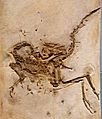Compsognathus facts for kids
Quick facts for kids CompsognathusTemporal range: Upper Jurassic
|
|
|---|---|
 |
|
| Compsognathus Oxford University Museum of Natural History note the narrow skull and long snout. |
|
| Scientific classification | |
| Kingdom: | |
| Class: | |
| Superorder: | |
| Order: | |
| Suborder: | |
| (unranked): | |
| Family: |
Compsognathidae
|
| Genus: |
Compsognathus
Wagner, 1859
|
| Species | |
|
C. longipes Wagner, 1859 (type) |
|
Compsognathus was a small meat-eating theropod dinosaur. It lived at the end of the Jurassic period, about 144 million years ago. This dinosaur was about one meter (3 feet) long. It walked on two legs and used its long tail to help it balance.
Scientists have found two almost complete Compsognathus skeletons. One was found in Germany and was about 89 centimeters (35 inches) long. The other, found in France, was larger at 125 centimeters (49 inches) long. The German fossil was discovered more than 150 years ago in a place called the Solnhofen Limestone in Bavaria.
The larger French specimen was found in 1972 near Nice in southeastern France. Even though it was first thought to be a different species, scientists later agreed it was another example of Compsognathus longipes.
We know what Compsognathus ate for sure. The remains of small, quick lizards have been found inside the bellies of both fossil specimens. For a long time, Compsognathus was thought to be the smallest dinosaur. However, now the smallest known dinosaur is Micropachycephalosaurus.
Contents
Why Compsognathus is Important
About 150 years ago, a scientist named Thomas Henry Huxley studied Compsognathus. He was known as "Darwin's bulldog" because he strongly supported Charles Darwin's ideas about evolution. Huxley compared Compsognathus with the first fossil bird, Archaeopteryx.
Both of these fossils were found in the same type of rock. This rock is called Solnhofen Limestone and is found in Bavaria, Germany. These rocks are from the end of the Jurassic period, about 144 million years ago. Huxley noticed that Archaeopteryx and Compsognathus looked very similar. The main differences were the front limbs and feathers of Archaeopteryx.
Huxley's studies showed that birds and reptiles are closely related. He grouped them together under the name Sauropsida. He concluded that birds likely evolved from small meat-eating dinosaurs.
What Compsognathus Ate
The fossil of a lizard found inside the German Compsognathus shows what it ate. This lizard was found in the dinosaur's chest area. At first, some thought it might be a baby Compsognathus. But in 1903, Franz Nopcsa confirmed it was a lizard.
Later, a scientist named Ostrom identified the lizard as a Bavarisaurus. This lizard was known for being fast and agile, with a long tail and strong legs. This discovery suggested that Compsognathus must have had excellent eyesight. It also needed to be able to speed up quickly to catch its prey. The Bavarisaurus fossil was found in one piece. This means Compsognathus probably swallowed its prey whole without chewing. The French Compsognathus fossil also had lizard remains in its stomach.
How Big Was Compsognathus?
Compsognathus was once believed to be the smallest dinosaur ever. However, if the smaller German specimen was a young dinosaur, then there are other dinosaurs that were even tinier.
Some of the smallest dinosaurs known today include:
Images for kids










